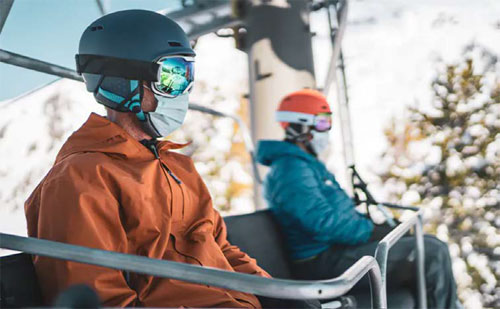Brice Wallace
Skis? Check. Warm clothing? Check. Ski pass? Check.
However, for people venturing out to hit the slopes this winter, Ski Utah’s leader is suggesting they bring along a couple of other items: face masks and information.
At the organization’s season preview news conference, Nathan Rafferty stressed that Utah’s ski resorts will have a variety of COVID-19 rules in place and urged a “know before you go” approach.
“There are many different protocols indoors at some of the ski areas,” said Rafferty, president and CEO of Ski Utah, the marketing arm owned and operated by the Utah ski resorts that make up the Utah Ski & Snowboard Association. “I think it’s a really safe bet to tuck a mask in your pocket and make sure you know what the protocols at the various resorts are, because they’re really going to vary this year.”
In some cases, a resort might require skiers to be fully vaccinated. Others may require masks at their lodges and restaurants. Some might cut the number of people allowed on the trams or chair lifts, he said.
“And we expect that this might change over the year,” he cautioned.
That is in deep contrast to a year ago, he said, when all resorts were “all the way to the max” with COVID precautions, including masks while in lift lines, shrunken capacity on those lifts and even reservations. The focus was to open and operate using best practices to ensure the safety of guests and employees, he said.
Rafferty suggested that skiers check skiutah.com or the resort websites to ensure they know what to expect.
“It’ll be easy, and I think if everybody skis with a mask in their pocket and they’re ready to don that when they go inside, it’s going to be a great experience,” he said.
While the experience outdoors likely will be similar to pre-pandemic times, he said skiers should anticipate some “tiny little changes” indoors. “This season is really, in many ways, getting back to normal. I would say ‘getting back to normal, almost,’” he said, saying the outdoor experience “will be our amazing Utah that you’ve known for many, many years.”
The experience last year was anything but normal as COVID put resorts’ operations in jeopardy.
“This time last year, we were wondering if we were even going to open or not, and it turned out to have a pretty fantastic ski season. But it was for sure a tricky time,” Rafferty said.
But even with COVID and below-average snowfall, Utah saw a record of 5.3 million skier days (a “skier day” is defined as one person visiting a ski area for all or any part of a day or night for the purpose of skiing/snowboarding). That topped the 5.13 million skier days of the 2018-19 season.
“Caught us and especially me a little bit by surprise, going into a year where in November we didn’t know we’d be open, to have finished a ski season with an all-time record,” Rafferty acknowledged.
Nationally, the industry saw 470 ski areas open and stay open, not missing a single day due to COVID, he said. As a result, it had its fifth-best season, with 59 million skier visits, but Rafferty was geeked about another national number: 10.5 million participants, a record high.
“I think that’s going to benefit us, our industry, really in the long run,” he said. “There were a lot of people that came off the couch — we call them ‘lapsed skiers’ in our industry — people who had maybe put it to the side and hadn’t skied for a while, and the menu of activities to do during the long COVID winter last year was pretty small, so we saw a lot of people reengage in the ski business and the ski industry, which we’re really grateful for.”
COVID did impact skiers activities, as some skied on weekdays rather than weekends or during afternoons, he said. In the Rocky Mountain region, 54 percent of skier days were midweek, up from 38 percent the prior season. “Those numbers really reflect that skiing was one of the best ways to socialize and be with your family safely during the pandemic,” Rafferty said.
Looking ahead, Rafferty listed several improvements skiers can expect this season, including new lifts, expanded parking, enhanced lodging and expanded night skiing, depending upon the resort. Booking data for the upcoming season also is showing a return to normal as people are “more comfortable with travel these days,” he said.
But snowfall is a main factor in determining what kind of season numbers the industry will see in 2021-22. Already several resorts have had to postpone their planned opening days due to a lack of snow.
Rafferty said it reminded him of late 2001. In mid-November, prior to the 2002 Olympic Winter Games, the weather was warm and “there wasn’t a flake at 10,000 feet.” But when he returned from an out-of-town Thanksgiving weekend trip, “it was a new world” because more than 100 inches fell in 100 hours.
“So, things can come quick and fast, and we’ll hope for some changing weather patterns soon,” he said. “But I’m sure we’re going to be up and skiing in the very, very near future.”








